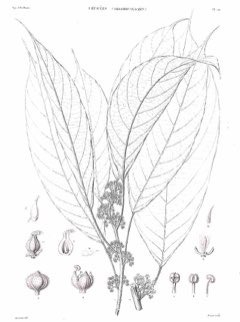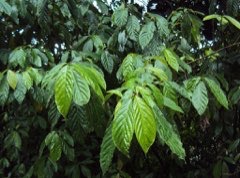 |
|
http://www.edibleplants.org |
 |
| Vinayaraj wikimedia.org |
Translate this page:
Summary
Commonly found in East Asia, Oreocnide integrifolia is an evergreen shrub or tree that grows usually about 5 - 20 m in height. It produces one of the strongest fibers in India which are made into ropes, nets, and coarse cloth. It has no known edible and medicinal uses. It can be grown through seeds, cuttings, and root cuttings.
Physical Characteristics

 Oreocnide integrifolia is an evergreen Tree growing to 12 m (39ft) by 12 m (39ft) at a slow rate.
Oreocnide integrifolia is an evergreen Tree growing to 12 m (39ft) by 12 m (39ft) at a slow rate.
See above for USDA hardiness. It is hardy to UK zone 10.
Suitable for: light (sandy), medium (loamy) and heavy (clay) soils. Suitable pH: mildly acid, neutral and basic (mildly alkaline) soils. It can grow in full shade (deep woodland) or semi-shade (light woodland). It prefers moist or wet soil.
UK Hardiness Map
US Hardiness Map
Synonyms
Urtica acuminata Roxb. Villebrunea integrifolia Gaudich.
Plant Habitats
Edible Uses
References More on Edible Uses
Medicinal Uses
Plants For A Future can not take any responsibility for any adverse effects from the use of plants. Always seek advice from a professional before using a plant medicinally.
None known
References More on Medicinal Uses
The Bookshop: Edible Plant Books
Our Latest books on Perennial Plants For Food Forests and Permaculture Gardens in paperback or digital formats.

Edible Tropical Plants
Food Forest Plants for Hotter Conditions: 250+ Plants For Tropical Food Forests & Permaculture Gardens.
More

Edible Temperate Plants
Plants for Your Food Forest: 500 Plants for Temperate Food Forests & Permaculture Gardens.
More

More Books
PFAF have eight books available in paperback and digital formats. Browse the shop for more information.
Shop Now
Other Uses
Fibre String
Other Uses A brown fibre is obtained from the stems[46 , 387 , 454 ]. Strong, and flexible, it is made into ropes, nets, and coarse cloth[387 ]. This is one of the strongest fibres produced in India[454 ]. The fibre is extracted from shoots less than 12 months old. The outside green skin or bark and a little slimy matter are scraped off, then the ribbons of partly cleaned fibre are stripped from the shoots, the inside of these ribbons is next scraped with a knife so placed in the hand as to allow the edge to rest against the forefinger. The strips are drawn through repeatedly in order to remove the slimy and gummy substances from the inner face. After being cleaned in this way, the ribbons are left to dry in the shade. Wien fully dried they are next steeped in water and wood-ashes for about twenty-four hours, and then boiled in rice water for four hours. The fibre will then be found to be quite free from gum, and may be separated into fine threads[439 ]. An alternative method, which results in a coarser fibre suited to making ropes, nets etc, is to take off the ribbons when the shoots are in a half-dry state without first scraping off the outer bark and gum. The inner face is also left coated with the slimy substance. The fibre is then purified it in a coarse way by washing it in lime and then twisting it into twine, or simply dividing up the ribbons and without any preparation twisting these into twine[439 ].
Special Uses
Coppice
References More on Other Uses
Cultivation details
An understorey tree of wet evergreen forests, it requires a position in dappled shade[439 ]. Requires a fertile, humus-rich soil[146 ]. The tree grows freely and quickly, and coppices readily[387 ]. It can be coppiced annually to provide a regular supply of stems from which to extract fibre[439 ]. Although this species is in the nettle family (Urticaceae), it does not have stinging hairs on the leaves or stems[266 ]. A dioecious species, both male and female forms need to be grown if seed is required[266 ].
References Carbon Farming Information and Carbon Sequestration Information
Temperature Converter
Type a value in the Celsius field to convert the value to Fahrenheit:
Fahrenheit:
The PFAF Bookshop
Plants For A Future have a number of books available in paperback and digital form. Book titles include Edible Plants, Edible Perennials, Edible Trees,Edible Shrubs, Woodland Gardening, and Temperate Food Forest Plants. Our new book is Food Forest Plants For Hotter Conditions (Tropical and Sub-Tropical).
Shop Now
Plant Propagation
Seed - Cuttings Root cuttings
Other Names
If available other names are mentioned here
Wild Rhea, Assamese: Ban rhea, Bon rhea, Chho-oi-paroli, Garo: Khilkhra, Sejugbu, Gingsining, Khasi: Dieng teingbah, Tillejwat
Native Range
Coming Soon
Weed Potential
Right plant wrong place. We are currently updating this section.
Please note that a plant may be invasive in one area but may not in your area so it's worth checking.
Conservation Status
IUCN Red List of Threatened Plants Status : This taxon has not yet been assessed

Growth: S = slow M = medium F = fast. Soil: L = light (sandy) M = medium H = heavy (clay). pH: A = acid N = neutral B = basic (alkaline). Shade: F = full shade S = semi-shade N = no shade. Moisture: D = dry M = Moist We = wet Wa = water.
Now available:
Food Forest Plants for Mediterranean Conditions
350+ Perennial Plants For Mediterranean and Drier Food Forests and Permaculture Gardens.
[Paperback and eBook]
This is the third in Plants For A Future's series of plant guides for food forests tailored to
specific climate zones. Following volumes on temperate and tropical ecosystems, this book focuses
on species suited to Mediterranean conditions—regions with hot, dry summers and cool, wet winters,
often facing the added challenge of climate change.
Read More
Expert comment
Author
(Gaudich.) Miq.
Botanical References
Links / References
For a list of references used on this page please go here
A special thanks to Ken Fern for some of the information used on this page.
Readers comment
| Add a comment |
|
If you have important information about this plant that may help other users please add a comment or link below. Only comments or links that are felt to be directly relevant to a plant will be included. If you think a comment/link or information contained on this page is inaccurate or misleading we would welcome your feedback at [email protected]. If you have questions about a plant please use the Forum on this website as we do not have the resources to answer questions ourselves.
* Please note: the comments by website users are not necessarily those held by PFAF and may give misleading or inaccurate information.
To leave a comment please Register or login here All comments need to be approved so will not appear immediately.
|
Subject : Oreocnide integrifolia
|
|
|
|